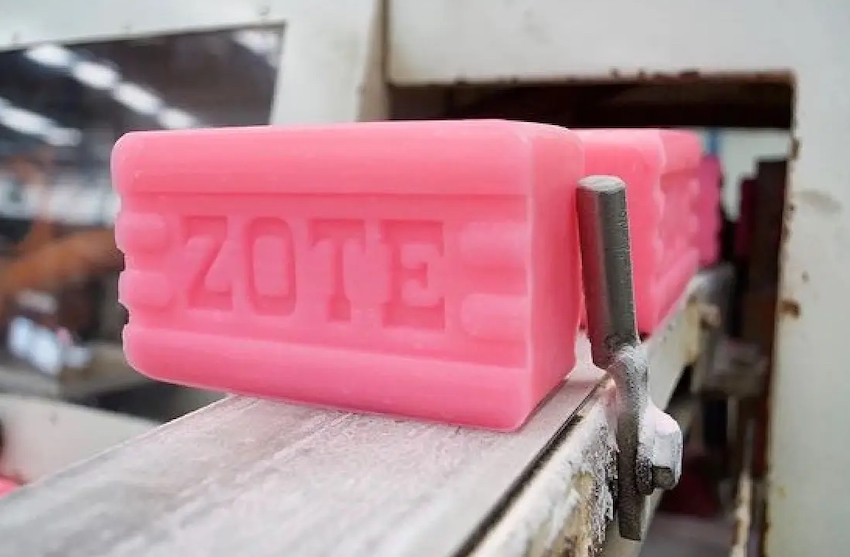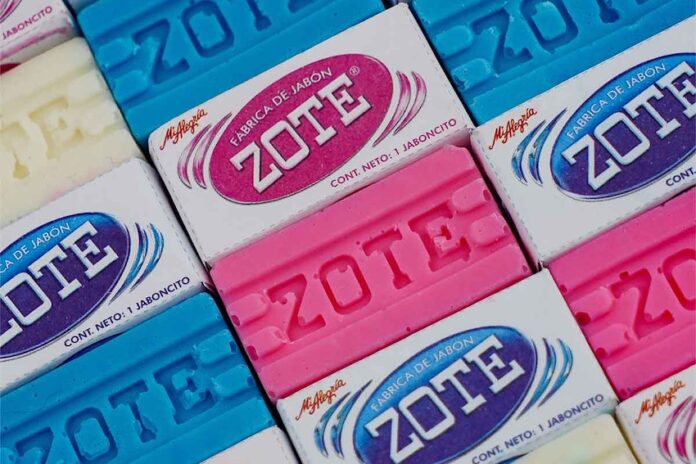I don’t think I’m exaggerating when I say that almost every Mexican grew up with a grandmother or mother whispering alchemical secrets over the laundry. These weren’t just household tips — they were closer to rituals, formulas worthy of a medieval guild. Scrub your clothes with jabón Zote. For whites, use the white bar; for colored fabrics, the pink one. Boil them with baking soda and vinegar. Let the pot rest under the full moon. Scrub again until your arms ache. Then hang the laundry where the sun can bless it.
Zote is the talisman at the center of these domestic rites — passed from hand to hand, word to word, stubbornly outlasting the global detergent empires of Procter & Gamble and Unilever.

How did a Mexican soap become one of the country’s most beloved brands? The answer lies in a time when hygiene itself was a collective endeavor.
Hygiene a century ago
Today, most Mexican homes — even those without a washing machine — have a washboard sink, and showers are fixtures of daily life. But a century ago, bathing and laundering were communal acts. Only the wealthy enjoyed private bathrooms; most people bathed in public bathhouses and scrubbed clothes on shared stone washboards, often fed by the same wells or springs.
These spaces were more than practical—they were social. They carried the hum of gossip, the kind of chatter so enduring that even today, when someone has irresistible news to spill, they’ll say “te tengo chisme de lavadero”—laundry gossip.
It was within this world that the González Padilla brothers from Tepatitlán, Jalisco, spotted an opportunity. Soap was not yet mass-produced. Each town had its own artisan who transformed animal fats and vegetable oils into rough, utilitarian bars.
The birth of La Corona
It was 1920. The Revolution had ended, and Mexico City pulsed with a desire for normalcy. Esteban, Loreto, and Daniel González Padilla arrived in the capital selling animal fat—then a scarce, prized raw material for soapmaking. But someone suggested a better idea: why not make the soap themselves?
They joined forces with master soap maker Zenón Martín del Campo and set up shop at Peralvillo Street No. 24, inside the Baños Corona bathhouse. Soon, shoppers heading to bathe began saying, “vamos a La Corona por jabón”—let’s go to La Corona for soap. Thus, the name of one of Mexico’s most enduring factories was born.
Their first bar, Tepeyac, appeared almost immediately. Demand surged. Within a decade, mule carts gave way to La Corona’s first motorized truck. By the 1930s and 40s, soaps like Corona and Roma dominated the market, fueling steady, unstoppable expansion.
Expansion and innovation
In the 1950s, Esteban’s son, Antonio González, took the reins. He relocated operations to Xalostoc, State of Mexico—where the factory still stands today—and launched La Corona into detergents in 1954. Unlike traditional soaps, detergents relied on petrochemical derivatives that dissolved grease with scientific efficiency.
But the defining moment came in the 1970s, when La Corona absorbed the production of Zote. Originally produced in Querétaro, the soap was reimagined with perfume and top-quality ingredients, then refined into Zote Rosa. Marketed as both laundry and bath soap with high quality, and extremely low price, it quickly became a sensation. Even after regulations prohibited its sale as a labeled bath product, women continued to use it that way—and still do. Today, beauty vloggers swear by Zote Rosa as the best way to clean makeup brushes. And almost every family has an elder who swears their hair was never more lustrous than when they washed it with Zote Rosa.
Innovation snowballed. In 1972, La Corona acquired Aceites Finos S.A., producer of the now-ubiquitous 1-2-3 cooking oil, and entered the edible oils business. As habits evolved, the company diversified again, introducing liquid laundry soaps—always with one ear tuned to consumer needs.
The secret to longevity
Unlike many Mexican companies swallowed by foreign buyouts, La Corona has remained a family enterprise. The González Padilla descendants still run it, treating their more than 5,000 employees as kin. Many families have worked at the plant for generations, passing down not just jobs but loyalty.
Their philosophy is almost radical in its simplicity. For decades, they refused to advertise, believing quality and word of mouth were the best publicity. Only with the rise of social media did this shift slightly. What hasn’t changed is their commitment to keeping prices low, reinvesting in new technologies—from Mexico, the U.S., Italy, Germany, and Canada—and listening closely to consumers.
Since 1986, La Corona has exported its soaps abroad. Today, 15 percent of production goes overseas—to the U.S., Ghana, China, Korea, and beyond. The scale is staggering: more than 300 tons of Zote produced every day, over 30 million bars each month. In Mexico, six out of ten laundry bars sold carry La Corona’s mark. All this in a detergent market valued at $798 million in 2024, projected to reach $1.23 billion by 2033.
Recognition and responsibility

The company’s ethos has not gone unnoticed. In 2022, Statista and Forbes ranked La Corona the second-best employer in Mexico, outperforming even Silicon Valley giants like Google. That accolade reflects more than corporate success; it highlights La Corona’s conviction that prosperity is about human development as much as sales.
La Corona has built water treatment plants to recycle its effluents, cutting 27,000 tons of CO₂ emissions through sustainable practices. With low turnover, employees often build lifelong careers at the factory, forming an industrial family that spans generations.
From Foca, Carisma, and Venus Rosa to Roma, Blanca Nieves, and 1-2-3 Oil, La Corona’s products have quietly shaped Mexican daily life. The formula remains almost stubborn: high quality, low cost, and proudly Mexican.
Arte Zote
There’s something almost comic about Zote’s packaging. A no-frills block of soap wrapped in plain paper, stamped with bold blue or pink letters, and boasting the name “jabón Zote” that in Mexican Spanish sounds like both “soap” and “huge.” Yet despite its humble looks, Zote has survived the rise of detergents, the globalization of household brands, and the endless marketing campaigns of multinationals. In its own quiet way, Zote is as Mexican as tortillas or the Virgin of Guadalupe: ordinary, indispensable, and surprisingly resistant to change.
Over time, Zote has transcended its role as a tool of domestic ritual. Its pink and white bars—once humble, workaday objects—have become icons of Mexican culture. They appear on unofficial merch, inspire visual artists, and have been reimagined in sculpture and installations. Zote has slipped into the national imagination as more than soap: it is a symbol, both utilitarian and poetic, of Mexican resilience and ingenuity.
And in an age when multinationals rise and fall with the tides of Wall Street, La Corona endures like an old tree in Xalostoc—rooted, resilient, and fragrant with the pink scent of Zote.
María Meléndez is a Mexico City food blogger and influencer.
